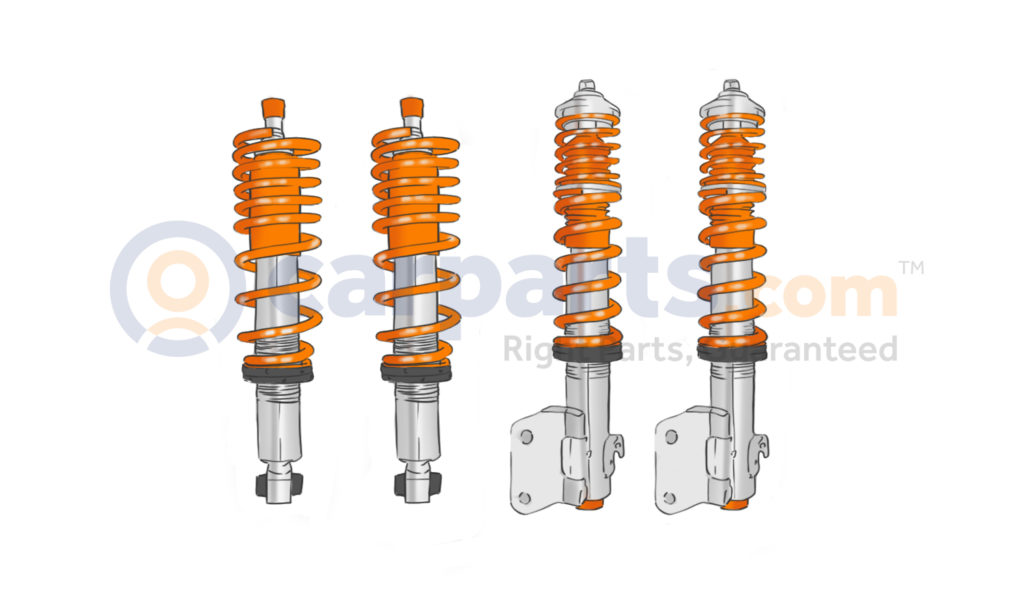People have a hard time understanding whether a coilover is a shock or a spring when, in fact, it’s both. Although that may sound confusing, we have the information you need to demystify this often misunderstood automotive part—plus, you’ll get to learn about lowering springs in the process.
Both parts are generally used for the same purpose—they’re used for lowering a vehicle and improving its handling. However, there are a few differences. In this article, we’ll compare coilovers and lowering springs to help you distinguish between the two and to help you decide which one you should get for your desired application.
What is a Coilover?

A coilover is a shock and coil spring combined into a single assembly. While this sounds like the description of a traditional MacPherson strut suspension part, in this case, the spring is typically a lot smaller in diameter and the outside shell of the shock housing is threaded, with a large nut that supports the lower end of the spring.
Some GM minivans came with rear air suspension shock/spring assemblies that did a similar job. Only those were designed to keep the vehicle level whenever it was loaded. These had a control module watching a ride height sensor while controlling a pump assembly to apply and release air pressure to the shocks as necessary.
As a shock/spring assembly, a coilover supports the weight of the vehicle with the integral spring, while the shock dampens spring oscillations. The design is both lightweight and simple, and unlike conventional shocks and springs, provides for manual height adjustment.
Coilover assemblies are used in both OEM and aftermarket applications. In many instances, coilovers are also adjustable and, therefore, can be used to raise or lower the height of a vehicle on demand.
What is a Lowering Spring?

Lowering springs are similar to the stock springs that you find on a vehicle from the factory. The main difference is, they’re shorter.
As you might guess, enthusiasts install lowering springs to drop their car’s ride height closer to the ground. Lowering a vehicle gives it a more aggressive appearance.
Also, a lower center of gravity improves handling characteristics due to the improved aerodynamics.
Unlike coilover assemblies, lowering springs do not contain a shock absorber. Instead, some lowering springs are stand-alone components, while others are integrated into an assembly with a strut, rather than a shock.
Lowering springs are fixed and non-adjustable.
Coilovers vs Springs: What’s the Difference?

Are you still confused about the difference between lowering springs versus coilovers? Then check out the table below.
| Coilovers | Springs | |
| Installation | Coilovers often come together as a single assembly. That can make installation easier. | Coil springs must be compressed prior to removal. Compressing the spring can be both difficult and dangerous, especially in a MacPherson strut-style suspension. |
| Price | $300 to $5,000 (depending on your car’s year, model year and make, as well as the brand you opt to purchase) | $109 to $1,100 (depending on your car’s year, model year and make, as well as the brand you opt to purchase) |
| Functionality | Coilovers combine both the shock and spring into a single assembly. The design supports the weight of the vehicle, while also dampening spring oscillations. Many coilovers are adjustable and, therefore, can be used to alter vehicle ride height on demand. | Lowering springs support the weight of the vehicle, while also providing a modified ride height. |
When Should You Get Coilovers?
Adjustable coilovers allow you to alter your car’s ride height on demand. In many instances, to fine-tune the suspension, you can also adjust the dampening rate of the assembly.
One benefit of coilovers is that any adjustments that are made can easily be reversed, which allows for fine-tuning not easily done with most other types of suspension.
Generally, coilovers are more expensive than coil springs. But they also provide a greater level of performance, so, in many cases, you get what you pay for.
When Should You Get Lowering Springs?
If you have a limited budget and want to achieve a lower, more aggressive look for your vehicle, then lowering springs might be the right move for you.

Lowering springs achieve the same goal of lowering your car and improving handling due to a lower center of gravity.
Where to Get Coilover Kits and Springs for Your Vehicle
When it’s time for repairs or upgrades, it’s important to get high-quality coilovers or lowering springs for your vehicle. After all, these suspension parts significantly impact your vehicle’s ride quality. Make sure that you get your money’s worth by shopping at CarParts.com.
We carry an extensive selection of coilover kits and springs for you to choose from. We’re confident in the quality of the parts in our catalog because we source them from the top manufacturers in the industry. These products are manufactured in world-class facilities, engineered to OE specifications, and designed to last as long as your vehicle’s lifespan.
Aside from our low-price guarantee, we also accept 60-day returns and offer a lifetime replacement guarantee for qualified purchases.
Place your order today, and get high-quality coilover kits and springs at the best prices!
Products Mentioned in this Guide
Any information provided on this Website is for informational purposes only and is not intended to replace consultation with a professional mechanic. The accuracy and timeliness of the information may change from the time of publication.


 Coil Over Kit
Coil Over Kit
 Lowering Springs
Lowering Springs



























